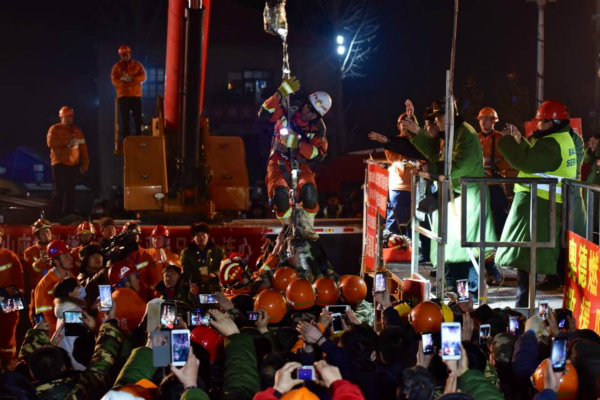 |
|
One of the four miners is lifted out of the collapsed gypsum mine after being trapped for 36 days. [Photo by Yu Peng for China Daily]
|
Video: The last miner being lifted out
Zhang Shuping, mayor of Linyi city in East China's Shandong province said that the city will have stricter oversight on its non-coal mining industry. The approval of new non-coal mines will be halted and an overhaul will be done in the existing 212 non-coal mines in the city.
Disused mine shafts, covering an area of more than 1,000,000 square meters, will also be dealt with by professional measures, the mayor said.
Zhang made the remarks after four miners have been lifted out on Friday night after being trapped for 36 days in a collapsed gypsum mine in the city's Pingyi county.
The four miners lifted out on Friday night are in a stable condition.
They have received biochemical tests on Jan 30 by professor Wu Dawei, chief of ICU in Qilu Hospital of Shandong University. The test indexes are normal including blood pressure and pulses except one miner is suffering from low levels of blood potassium. So far, the miners have no life threatening illnesses, but doctors will look over their health conditions for another two days.
The rescued miners are (in order of their being lifted out of the collapsed mine):
Zhao Zhicheng, 50, cage tender
Li Qiusheng, 39, cage tender
Guang Qingji, 58, signalman
Hua Mingxi, 36, forklift driver
It is the first time that trapped miners have been rescued through a large caliber hole in China and the third such case in the world, setting an example for mine rescue.
Rescuers dropped a rescue harness down the mine in Pingyi earlier in the night to lift the four miners who have been trapped since December 25.
Helmets and gloves were already transported underground as rescue equipments, according to China Central Television.
The mine collapse trapped 29 miners working underground on Dec 25. Eleven escaped or were rescued, one was confirmed dead and 13 others were listed as missing.
The four miners were found alive on Dec 30. Rescuers sent them food, drinks, clothes, medicine and lamps through a small hole drilled into the ground.
A medical team is standing by the collapsed mine in preparation to send the miners to ambulances for first aid. The miners may suffer from heart or brain problems due to overexcitement after being lifted to the surface, according to medical workers on the scene.
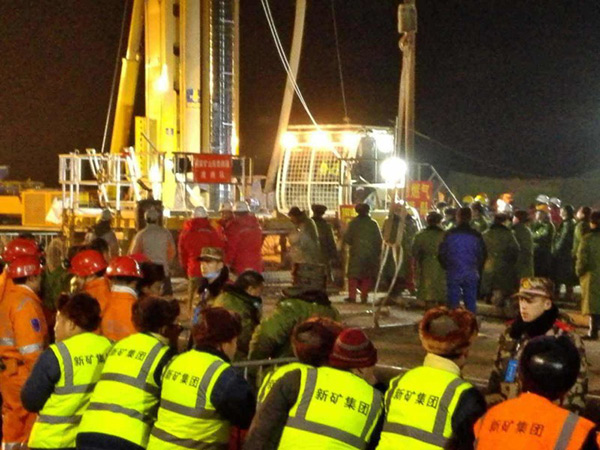 |
|
The rescue scene in Pingyi, East China's Shandong province. [Ju Chuanjiang and Zhao Ruixue/China Daily]
|
Rescue challenges
The rescue work faced many challenges due to the complex situation.
There were continuous cave-ins inside the mine, with some falling rocks weighing tons of kilos, which severely deformed pitshaft and almost blocked the pathway at the bottom of the mine.
Many pathways that rescuers dug out and restored were destroyed several times by the falling debris.
While boring holes in the ground drills were stuck many times due to the complex geologic structure.
Rescue bases were flooded by underground water and huge amount of water left by surrounding goafs was 60 meters higher than the area that miners were trapped. If widespread flooding had occurred the consequences were unthinkable.
Life underground
The four miners created a living space of six to eight square meters underground.
Officials at the rescue center talked to them through phone several times a day while psychologists chatted with them twice a day.
Video clips of the ongoing rescue work was also played to them to give them comfort and hope.
Rescuers also sent them poker cards through the hole for them to pass time.
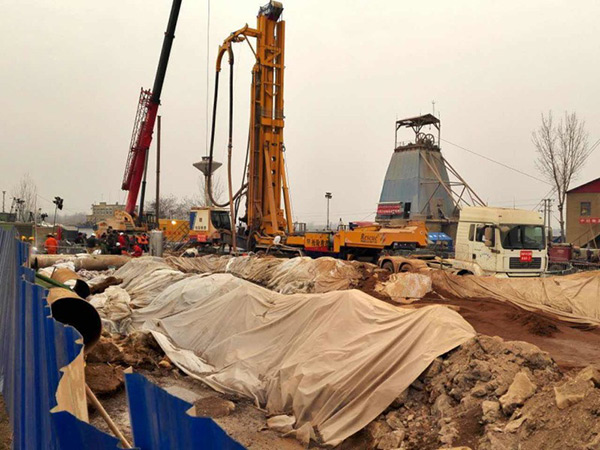 |
|
The rescue scene in Pingyi, East China's Shandong province. [Ju Chuanjiang and Zhao Ruixue/China Daily]
|
Who are the rescuers
The rescue workers are from the province's seven mine rescue specialist organizations.
They have experienced special hardships over the past more than 30 days, battling against cold.
More than 30 members of search-and-rescue teams have been living at the accident scene for a month, with many of them sleeping in their cars or tents.
Rescue workers only slept two hours every day, said Zhang Hongkun, director of engineer department with Order Group.
Liu Changyong, a project manager with Shandong Provincial Bureau of Geology & Mineral Resources, has been awake for two days, while supervising the welding work at the site.
"When the ascending tunnel was about to get through, we were so anxious," he said. "Many experts had tears in their eyes when it finally got through."
Meng Qingjun, 43-year-old, whose eyes have been red for days, was called up seven times in one night. He and his teammates haven't changed clothes for two weeks.
"I didn't change my clothes for two weeks, and was once woken up 7 times in a night to check on the drilling process," Meng said. "We were racing against time and fighting the tough environment. Many people got sick."
Jiang Tianlong, 32-year-old, has been welding pipes day and night. He finished 19 pipes on Thursday.
Lei Jiandong, a member of rescue team with China Coal Geology Engineering Corporation, got blisters all over his mouth. He hasn't had a whole night's sleep since Jan 6 when he entered the site to drill a back-up rescue hole.
To save the miners' lives, efforts have been made both at the frontline by the rescuers and by their families, who have sent clothes and medicines to rescuers, a team member told China Daily.
Guan Zhengfeng, former director of Guanzhuang village, offered to boil water for rescuers. The 68-year-old boiled 200 buckets of water every day for 30 days. Five of the 11 miners from his village were trapped underground.
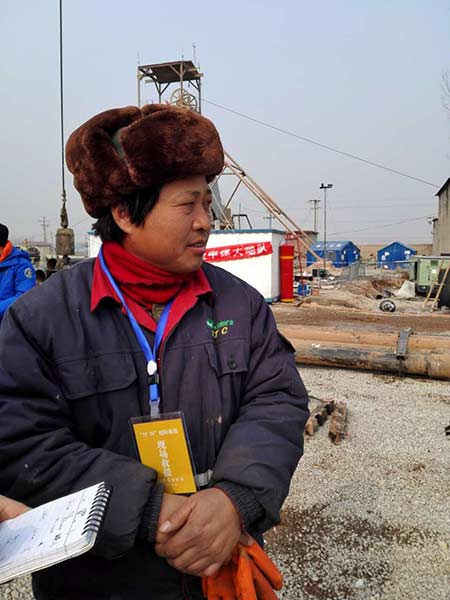 |
|
Li Youjun is the vice chief of the Huainan mining rescue team. [Photo by Ju Chuanjiang/chinadaily.com.cn]
|
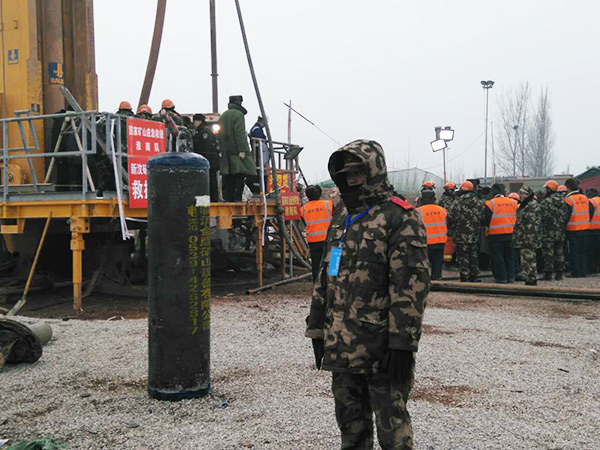 |
|
An escape capsule is seen at the rescue scene in Pingyi, East China's Shandong province. [Ju Chuanjiang and Zhao Ruixue/China Daily]
|
Timeline of gypsum miners' rescue:
Jan 29, 2016 -- Four miners were lifted to the surface alive after being trapped underground for 36 days.
Jan 4, 2016-- No additional survivors were found after rescuers managed to bore a hole 220 meters into the collapsed gypsum mine. Thirteen workers are listed as missing.
Dec 30, 2015-- Four miners were found to be alive after being trapped underground for five days.
Dec 29, 2015-- Four leaders of Pingyi county, including Party chief Feng Chengxiu and county head Liu Chunbo, were dismissed due to several accidents in 2015.
Dec 27, 2015-- Shandong issued a notice ordering all gypsum mines in Linyi to suspend operations and undergo safety checks. The order included mines in bordering Zaozhuang and Tai'an, as well as nearby depleted mines.
Dec 27, 2015-- The owner of the collapsed gypsum mine committed suicide by jumping into a mine shaft that had partly filled with water as he was assisting in the rescue.
Dec 26, 2015-- One person died and another worker was rescued.
Dec 25, 2015-- A gypsum mine of Yurong Commerce and Trade Co collapsed in Baotai, Pingyi county of Linyi, Shandong province, trapping 29 workers. Ten workers were rescued on this day.
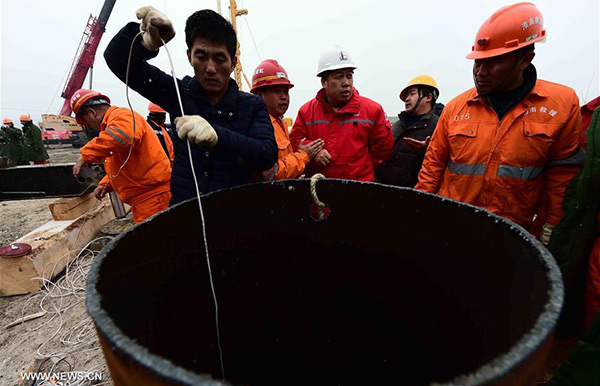 |
|
Rescuers work at a collapsed mine in Pingyi County, East China's Shandong Province, Jan 6, 2016. Rescuers managed to dig more than 200 meters down into the shaft of the collapsed mine on Monday, but found no new survivors. [Photo/Xinhua]
|
Previous successful cases of its kind
In Chile, Oct 2010
On August 5, 2010, 33 miners became trapped when Chile's San Jose mine collapsed. A total of 69 days later, all the miners were pulled from the mine alive.
The miners were trapped 700 meters underground and about 5 kilometers from the mine's entrance via spiraling underground service ramps.
The mixed crew of experienced miners and technical support personnel, with less experience working underground, survived for a record 69 days deep underground before their rescue.
A 5-inch wide hole became their lifeline, a vessel for food, water and supplies.
In the US, July 2002
On July 24, 2002, a work crew of nine men from the Quecreek Coal Mine in Somerset Pennsylvania inadvertently drilled into the adjacent abandoned Saxman Mine, liberating an estimated 50-60 million gallons of water into the active mine. The men were trapped in an air pocket within a 48-52 inch coal seam 240 feet underground for more than 3 days.
The rescuers started drilling a rescue shaft large enough for a rescue capsule to be lowered to the miners.
On the 28th of July, all nine men were retrieved safely from the mine.
By Ju Chuanjiang, Zhao Ruixue in Pingyi, Jiang Wei, Peng Yining, Yang Jie, Wang Zhaokun in Beijing (chinadaily.com.cn)
Using WeChat? Scan QR Code or Press the Fingerprint Below ↓
--- (Or ADD WeChat ID: OKOKOKOKnet)
